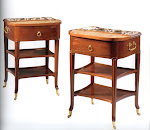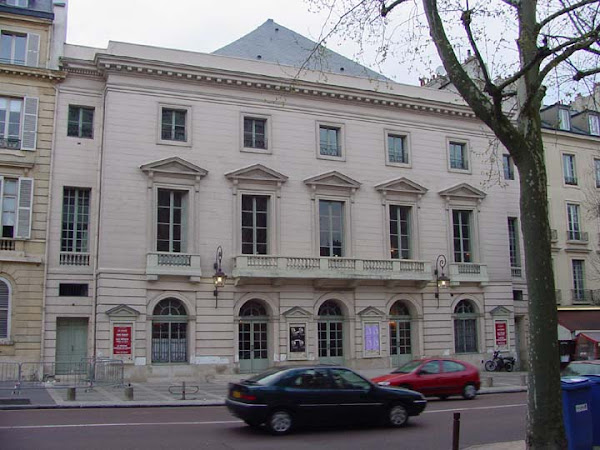Happily, the gallery's erudite but approachable owner, Leon Dalva, takes his stand with good humour, wit and has no intention of going the way of so many other galleries which once offered their enviable North American, Latin American, and European clientele the very best examples of French ebenisterie and meneuserie that tended, with few exceptions, to range from the periods of Louis XIV to The First Empire. Below are photos of an evening during which Mr. Dalva, with his characteristic amiability, co-hosted an event at the gallery in 2013 at which I spoke to The American Friends of the Louvre and which was additionally organized by Thierry Millerand and Kip Forbes. Mr. and Mrs. Dalva have long been very active and generous in their efforts to fund raise for this admirable organization that has played a role in supporting the recently newly restored and opened galleries at the Louvre in which the best furniture and decorative arts of the Ancien Régime are currently displayed.
During my last visit in 2014, I was mesmerized by the seemingly effortless ability of Dalva Brothers to continue to maintain an inventory of which not once item would have been out of place in an apartment at The Chateau de Versailles or for that matter at Pavlosk Palace in Russia. Several floors are all set up with period evocations against which Mr. Dalva offers clients the most royal examples of French 17th thru early 19th Century furniture. In this essay, I'd like to share some of my selections of what I consider to be particularly special and worthy of a glance and some observation from the category of marquetry.
Chronologically, the clock with brazenly polychromatic inlay that I'd like to cite, is actually Italian from Florence with typical Florentine style inlay that brings to mind the exuberance of the Medici Court and the Medici workshops production of Pietra Dura. But this is marquetry! Although my focus is French Marquetry, I'm commencing with this example as there is evidence that a very similar clock of Florentine inlay was owned by Louis XIV. After all, he did have Medici blood in his veins and looked to the glory of the Medici for inspiration in his own aspirations for Versailles. As is the instance with the clock once owned by Le Roi Soleil, this one in Dalva Brothers inventory, also has a later inserted French movement. The movement in this clock is signed by Baltasare Martinot, of Paris. It was placed inside the Florentine body in the early 18th Century. The clock case itself is really a small piece of Florentine Architecture with its form that is essentially indistinguishable from a building's facade. The walnut case is embellished with ivory, natural and stained bone, ebony, and mother-of-pearl. The "facade" has a pair of free standing columns flanking the dial plate and which are decorated with inlaid floral swags.
The columns are surmounted by an open pediment with ivory balustrade.
The plinth on the base of support is similarly inlaid with birds and flowers and has a drawer for storage.
A whimsically inlaid marquetry commode of the more lighthearted Louis XV period owned by Dalva Brothers is this bombé commode bearing the stamps of both M. Hansen and J. B. Saunier. Like many examples of commodes from the mid 18th Century in Paris, it is sans traverse which means that the marquetry design of the front is uninterrupted and that only a hairline separates the upper from the lower drawer. The exuberance of the marquetry in this example is exceptionally witty and playful! A curvaceous central cartouche is flanked by a pair of kidney shaped fields on the front. The central cartouche has a stylized fleur-de-lis on the top and depicts fanciful birds on branches with leaves and flowers that come together below and are tied by a pretty ribbon. There are no applied ormolu handles and this was probably the intent of the creator to really allow the eye to focus on the exciting marquetry design. The drawers are opened by the key inserted in the discrete key holes. Though there are lovely ormolu mounts along the front corners comprising finely executed gleaming chutes and sabots. The marble is apparently of the breche d'alep variety.
One of the loveliest of the tables boasting bravura marquetry at Dalva Brothers is this one below stamped by Brice Peridez who as not as widely known as many of his contemporaries among today's collectors and became a master in 1738. It is a three-legged circular table in which the top with its customary reticulated gilded metal gallery is inlaid with marquetry as well and not with the more usually seen marble. The charming sinuous inlaid vines of the frieze drawer are also worth noting. But the table is of particular distinction due to the repeating lower level. Here the creator (perhaps working in concert with a very discerning client having very definite requirements?) placed more than the usual platform and the bottom tier in this table is the same thickness as the upper tier and provides the owner additional storage concealed by more joyful floral marquetry. The top of the lower tier has a pair of hinged doors that open to reveal storage below.
My great favourite in the current inventory of Davla Brothers has to be a significant secretaire `a abattant by the legendary David Roentgen that is almost identical to one this giant among ebenistes also created for an important Russian client in the 18th Century and which is currently in the world renowned Niarchos collection in Paris. The main front panels on this example display what can be asserted to be arguably among this celebrity ebeniste's finest most delicately executed marquetry inlay depicting flowers and exotic birds among trees. The front abattant has veneered panels depicting agricultural tools and flowers suspended from twisting ribbons that bring to mind the bucolic reveries of Marie Antoinette at her Hameau at Petit Trianon. This is Roentgen as good as Roentgen gets in any of the world's best museums!
....
While the corner mounts atop that join the upper frieze clearly
already look to the Classicism one associates with the 1770's with the
imposing laurel leaf swags surrounding the oval medallion.
In
this time that has witnessed a fundamentally and radically changed
climate of collecting and in the very interpretation of domestic life
among the sophisticated and the affluent who have historically defined L'Art de Vivre,
it's obvious these masterpieces, once coveted by princes and later
captains of industry who followed the former's example of unquestioned
good taste, have lamentably waned in their desirability to a newly
emerging generation of well to do collector whose lack of interest is
entirely due more to a severe and lamentable lack of education and
examples from the ranks of elite society as provided to preceding
emerging generations of wealthy new potential patrons and collectors.
Today's newly emerging affluent whose predecessors turned to time
honoured examples from the Faubourg Saint Germain, London's Mayfair or
New York's 400, are turning away from a nearly 150 year tradition of
living with important and elegant furniture and decorative arts of the Ancien Régime.
This tradition not only communicated a certain status and degree of
education, but it was part a sincere societal effort to maintain a
standard of civilized living and, as in the case of a collector like the
redoubtable Mrs. Dodge and Mrs. Wrightsman, one day endow important
museums with the finest examples from which the next generation of
connoisseurs could learn and be enriched.
In
this new changing and uncertain world, a visit to Dalva is a visit to
the Mount Olympus of the world of collecting great French 18th Century
furniture. Is this an expensive collecting category? Yes...
...
But then it really is not when you consider the cost of a masterpiece
of 18th Century French marquetry as currently available a Dalva Brothers
is modest next to what is doubtfully touted as "artisan" contemporary
furniture in the current retail market and what is passing for
"Contemporary Art" for seven dizzying figures at the World's
international art fairs. By comparison, Dalva's offerings which are
mostly in the 5 figures (with some just in the 4 figures and a few more
in the 6 figures) are a sound acquisition by comparison and will
probably pass the test of time better than many current crazes when all
is said and done.
























